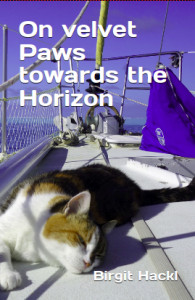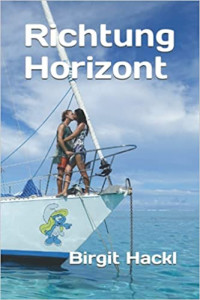Last night the wind turned into a light breeze–ideal timing or we would have arrived too early. Now we’re sailing down the western side of Raroia towards the pass, it’s a beautiful sunny morning, just a few tiny rainclouds around and we hope to catch one of them as Pitufa’s in dire need of a boatwash. In the shade of the island it’s calm, so Leeloo has declared the passage for over and has left her sea berth for a second breakfast (during a rough passage she only gets up for urgent errands–water, toilet and back to bed) ![]()
2020
15
Jun
Approaching Raroia
2020
14
Jun
Fast passage
The fast ride goes on, fortunately it’s the tack heeling towards the galley, so cooking’s still okay… We’ve had the lure out since we left, just the right conditions for an oh-no-not-now fishy, but still no luck. Apart from that the fourlegged and twolegged crew are doing well. 100 nm to go!
2020
13
Jun
Fast sailing
The squally weather continues, not much fun, but at least we’re fast, averaging 6 knots. 235 nm to go!
2020
12
Jun
Unpleasant night
Last night one squall followed the other, keeping the watch busy. We had mostly 20 knots from the NE, gusting 30. Now conditions have settled a bit. 370 nm to go!
2020
11
Jun
Sunny day
It’s a sunny day, lighter winds, so we’re going a bit slower, but it’s very comfy sailing. 510 nm (out of 600) to go to Raroia!
2020
11
Jun
Sunny day
It’s a sunny day, lighter winds, so we’re going a bit slower, but it’s very comfy sailing. 510 nm (out of 600) to go to Raroia!
2020
10
Jun
Towards the Tuamotus
After a week of stormy, rainy weather we now have stable conditions again, so we set out today at noon for the Tuamotus! 15-20 Knoten aus ONO, Fahrt 5-6 Knoten
2020
02
Jun
Naked in the rain
After a long period of stable weather we saw a convergenze zone with rain and wind afterwards approaching, tucked in and prepared the rain collection system. During breakfast we heard heavy rain pounding on the island next to us and minutes later bucket-loads of water splashed on us. We could see hasty preparations on neighbouring boats–nobody wants to accumulate wet clothes, so people tend to hop around naked, adjusting hoses and spreading canvas… Then a few late-comers got to anchor just in the middle of the downpour.
We have a watermaker, but rain means high-quality water for free, so we’re always happy to catch us much as possible. As soon as the tanks are filled the excitement wears off, so we hope that the predicted week of nasty weather will be cut short.
2020
31
May
Propaganda and protests in Tahiti
It looks like we won’t have another weather opportunity for at least a week, so we decided to exchange our broken old wind instrument for a new one. Christian’s been up and down the mast 5 times in the past 2 days, getting the old wind instrument off, new one on, pulling cables, etc. Of course that means I’m on duty all the time as well, hauling him and bits and pieces up and down whenever he shouts–quite some work-out for both of us ![]()
While everything’s nice and relaxed on the outer islands, we hear from friends in Tahiti that the situation there is getting precarious. The former official anchorage off Marina Taina is supposed to be closed down soon, therefore lots of cruisers anchored off the airport and got stuck during the Covid confinement. The policy of sending all new arrivals straight to Tahiti to check in there has led to a whole fleet there. Now locals protest against anchored boats and the usual propaganda in the media accuse cruisers to pollute the lagoon without adding to the economy. Completely ridiculous when you consider how much we all spend for groceries, boat parts, etc.
Especially now that no flights get into French Polynesia people should realise that WE are their only tourists here. Instead of pampering us and urging us to spend money they want us to disappear into thin air…
2020
30
May
Back
After a few hours of clanging and banging with the gennaker collapsing and filling in high waves and little wind we gave up and tacked back to the Gambier. No use damaging material with an unsettled forecast ahead. After 2 days of preparation and 1 day of sailing we’re back where we started from ![]()
2020
29
May
Light winds
The weather forecast promised a light, but do-able weather window to reach the Tuamotus. We had a preparation frenzy yesterday, sailed out after dark, drifted around for a bit and motored back into the lagoon–no wind. This morning we try again, the gennaker’s up and flying, but not much wind. We’ll see…
2020
28
May
Birthdays
Today my Mum would turn 80. She dreaded that ‘horrible number’ and said she would not celebrate that birthday… I could not fly home for her funeral, but I had a flight booked in May to be at her grave today. Now with the ongoing Covid-19 crisis there are still no flights going to/from French Polynesia and nobody knows when and it what form (with quarantine on both ends?) travelling will be possible again.
Christian wanted to fly to Austria for a much happier reason–his father will also turn 80 in a week. Unfortunately Christian won’t be there for the celebration…
2020
24
May
Mara’amu
French Polynesia has recently allowed boat traffic between archipelagos again (no flights yet). Therefore everybody here in the Gambier is eager to leave, because winter has arrived with a strong, cold Southeasterly (mara’amu) howling over the islands.
Even though the direction of this mara’amu would be good to sail to the warm Tuamotus, conditions are a bit too rough to be fun (4 m waves), so we’re waiting for the next weather window.
In the meantime we’re busy writing and working on the boat, wearing socks and hoodies in the evenings while having a mulled cider for sundowner (instead of the usual cold beer).
2020
17
May
Seven years in French Polynesia
On May 17 2013, exactly seven years ago we arrived in French Polynesia for the first time after a 24 day passage from Galapagos. Misled by popular sailing guides we had thought it prudent to wait until the end of the cyclone season, not knowing that this meant the end of summery weather here in the Gambier Islands. We stuck around until August and then fled from the cold, rainy and stormy weather up into the heat of the Marquesas.
We never thought then that we’d stay in FP for such a long time. Even though we explored westwards (Cooks and Tonga) twice, we always came back to the Gambier, our ‘cyclone season base’.
Now it’s getting colder again and usually we’d already be in the Tuamotus at this time of the year, but this year sailboats are not allowed to leave the archipelago they were in when the Covid-19 crisis started. We hope that these restrictions will be lifted before the weather gets nasty. Winter is coming…
2020
12
May
How to cruise in the Tuamotus
Due to the Covid-19 crisis all inter-island travel was forbidden in French Polynesia and boats arriving from Panama/Mexico/Chile/etc. have been ‘piling up’ in the Marquesas and Gambier. It looks like some inter-island travel may be allowed soon and then a fleet will head for the atolls of the Tuamotus.
As we’ve been around the area for 7 years now (and we move a lot and have explored many places off the beaten track) we have seen many examples how not overly well informed ‘newbies’ can make quite a few mistakes at their first encounter with atolls, causing damage to their own boats, but also to nature.
Under our ‘for cruisers’ section you can find lots of blog entries and links to articles about…
- how to enter an atoll safely (not to rely on apps and software, but to arrive early and watch out for phenomena)
- how to navigate safely (not relying on other people’s Waypoints or on charts that are often wrong, but with good light and a look-out on the bow)
- how to anchor around coral (with good light, in water that’s shallow enough to find the sandy spots, with a floated chain and not blindly in the deep with alibi floats)
- how to stay safe at anchor (by keeping an eye on the weather all the time and moving with or in anticipation of shifting winds)
- how to keep good relations with locals (by asking for permission if in doubt and by going to the mayor’s office to find out about local customs/fees)
- how to minimise the impact on wildlife on the few motus that actually still have some (not to greedily stock up with coconut crabs, landcrabs, lobsters as their numbers are reduced already by locals without much sense of sustainability, not to disturb the few motus with bird colonies by having beach parties and bonfires)
If you’re heading towards the South Pacific in the future or if you’re already here, check out our info and feel free to write an email if you have additional questions!




